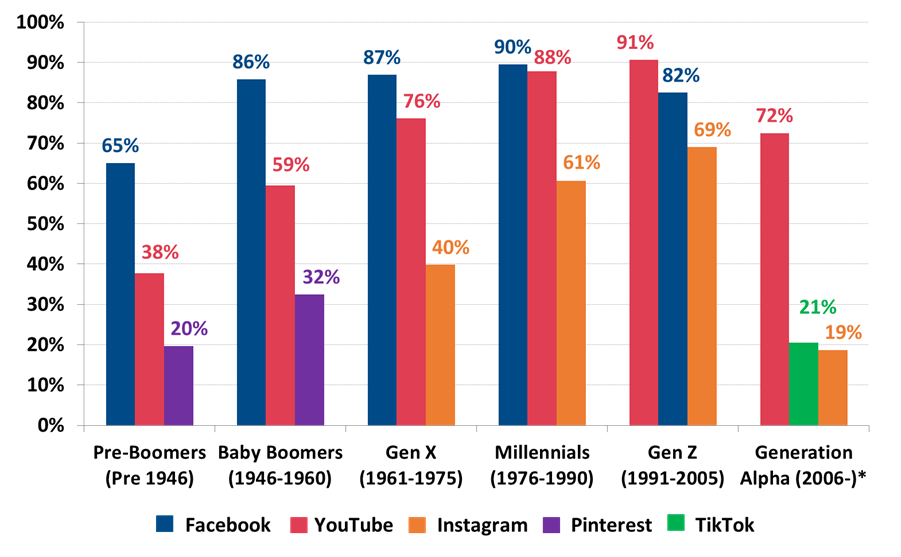Facebook and YouTube strong across all Generations but Pinterest, Instagram and TikTok have important user bases

Facebook and YouTube are easily Australia’s most widely used Social Networks and this strength is evident across different generations of Australians. However, there are other Social Networks led by Pinterest, Instagram and TikTok which also appeal strongly to particular demographics according to the latest research from Roy Morgan.
As Australia’s leading Social Network, Facebook is the most popular Social Network across several generations. Facebook is used by 65% of Pre-Boomers (born pre-1946), 86% of Baby Boomers (1946-1960), 87% of Gen X (1961-1975) and 90% of Millennials (1976-1990).
Video streaming site YouTube is the most popular Social Network for the two youngest Generations used by 91% of Gen Z (1976-1990) and 72% of Generation Alpha (2006-).
However, beneath these two market leaders differences in preferences really stand out.
Photo-sharing site Pinterest is the third most popular Social Network for both Pre-Boomers (used by 20%) and Baby Boomers (32%) while Instagram is the third most popular choice for Gen X (40%), Millennials (61%), Gen Z (69%) and Generation Alpha (19%).
The youngest kids on the block in Generation Alpha (aged 6-14) have also chosen to join new short-video site TikTok which is now the second-most popular Social Network for this generation used by 21% of ‘Alphas’.
In fact, more than two-thirds of the more than 1.6 million Australians who use TikTok are aged under 25 with younger members of Gen Z also joining TikTok in droves. For more detail on the new entrant to the Social Network scene see Roy Morgan’s special TikTok release here.
These results are based on in-depth Roy Morgan Single Source interviews with more than 25,000 Australians aged 14+ over the 6 months to February 2020 and over 1,000 interviews with Young Australians aged 6-13 years old during the six months to December 2019.
Michele Levine, CEO of Roy Morgan, says now more than ever Federal and State Governments need to make sure they’re choosing the most effective ways to reach different audiences with important public health messages:

“Clearly Social Networks like Facebook and YouTube, which are used by 84% and 76% of Australians respectively, are key channels Governments must use. However, there are other Australians who are more effectively reached through platforms such as Pinterest, Instagram and TikTok.
“Pinterest is now used by over 7.2 million Australians. Its reach is strong across all generations, but among Australians aged 60 and above it is the third most popular Social Network for both Baby Boomers and Pre-Boomers. These age groups are at the biggest risk from COVID-19, with 98% of the Australians who have died so far from COVID-19 being 60 or older.
“Gen X, Millennials and Gen Z are at a much lower risk from COVID-19 themselves but they can pass on the virus to more vulnerable members of society without even realising it. The high usage of Instagram amongst these generations makes it an ideal channel to reach younger Australians who may feel tempted to flout current restrictions because COVID-19 is an ‘old person’s disease’.
“And then there are the primary and early secondary school-aged children who use the short video service TikTok. It offers an opportunity to reach this young cohort with positive messaging about the important job they are doing to combat COVID-19, and to provide reassurance to those who may be anxious and concerned about circumstances they cannot control.“
Top Social Networks by Generation – February 2020

Source 1: Roy Morgan Single Source, September 2019 – February 2020, n=25,379. Base: Australians aged 14+.*Source 2: Roy Morgan Young Australians Survey, July – December 2019, n= 1,047. Base: Young Australians aged 6-13 years old.
View our range of Social Media and Online Communities Profiles.
For comments or more information please contact:
Roy Morgan - Enquiries
Office: +61 (03) 9224 5309
askroymorgan@roymorgan.com
Margin of Error
The margin of error to be allowed for in any estimate depends mainly on the number of interviews on which it is based. Margin of error gives indications of the likely range within which estimates would be 95% likely to fall, expressed as the number of percentage points above or below the actual estimate. Allowance for design effects (such as stratification and weighting) should be made as appropriate.
| Sample Size | Percentage Estimate |
| 40% – 60% | 25% or 75% | 10% or 90% | 5% or 95% | |
| 1,000 | ±3.0 | ±2.7 | ±1.9 | ±1.3 |
| 5,000 | ±1.4 | ±1.2 | ±0.8 | ±0.6 |
| 7,500 | ±1.1 | ±1.0 | ±0.7 | ±0.5 |
| 10,000 | ±1.0 | ±0.9 | ±0.6 | ±0.4 |
| 20,000 | ±0.7 | ±0.6 | ±0.4 | ±0.3 |
| 50,000 | ±0.4 | ±0.4 | ±0.3 | ±0.2 |
